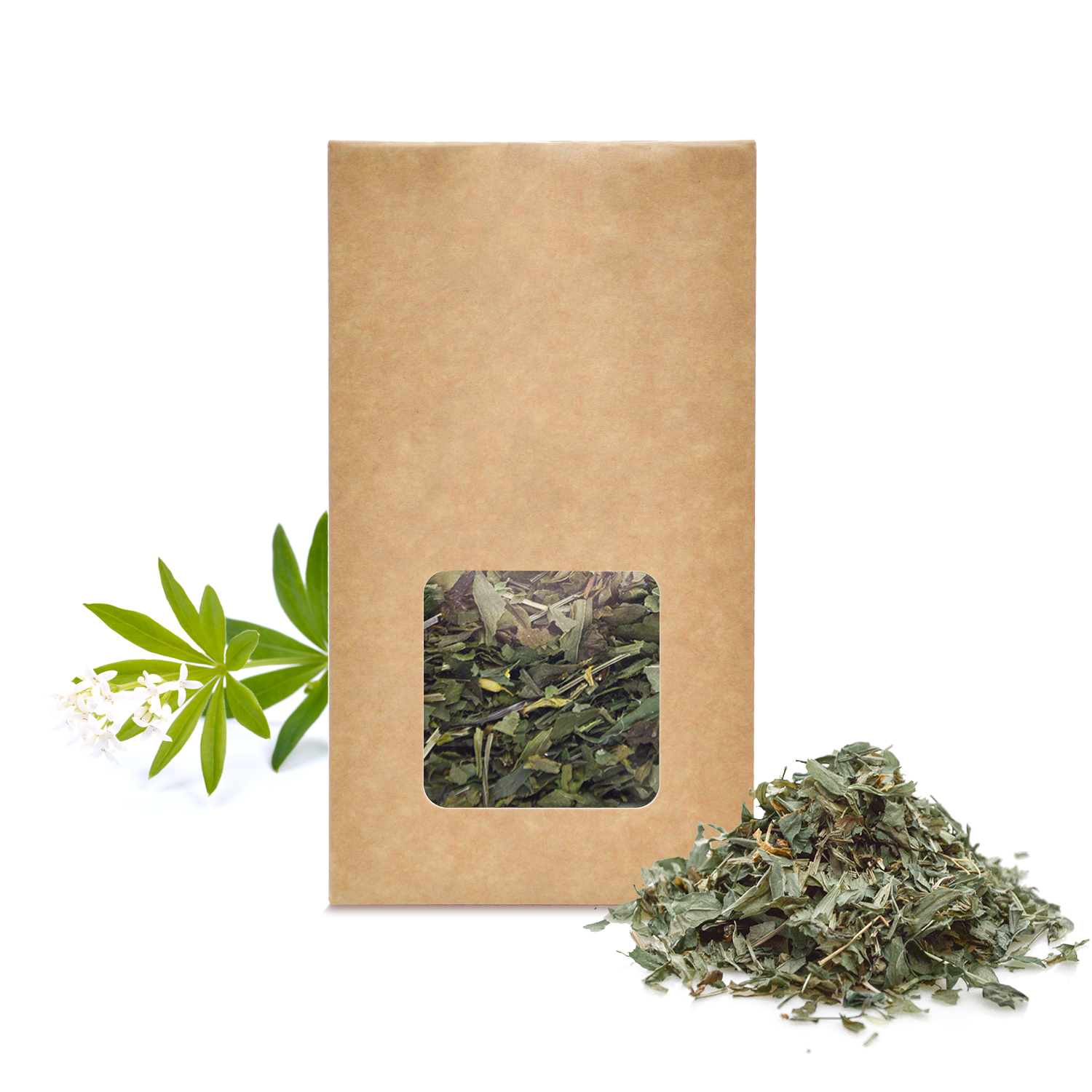
Woodruff is used against all disorders linked to nervousness, ranging from insomnia to palpitations, from headaches to digestive disorders of nervous origin. It is also used for its antiseptic and anti-inflammatory properties in cases of conjunctivitis or blepharitis or for its diuretic properties in cases of urinary infection. Latin name: Galium odoratum (L.) Scop. Part of the plant: aerial parts
This article was updated on 08/02/2023In case of Headache, Migraine
Recommended modes of use
In infusion
Pour the equivalent of 1 tablespoon of dry plant per cup of hot water, then let it infuse for 10 minutes. Drink 2 to 3 cups per day.
Plants often associated
In case of Sleep problems, Insomnia
Use at the end of the day and/or in the evening before bed.
Recommended modes of use
In infusion
Pour the equivalent of 1 tablespoon of dry plant per cup of hot water, then let it infuse for 10 minutes. Drink 2 to 3 cups per day.
Plants often associated
In case of Nervousness, Palpitations
Recommended modes of use
In infusion
Pour the equivalent of 1 tablespoon of dry plant per cup of hot water, then let it infuse for 10 minutes. Drink 2 to 3 cups per day.
Plants often associated
In case of Conjunctivitis
Recommended modes of use
In compress
Pour the equivalent of 1 tablespoon of dry plant per cup of hot water, then let it infuse for 10 minutes. Filter then leave to cool. Soak a compress or cloth with the preparation then apply to the affected areas.
In lotion
Pour the equivalent of 1 tablespoon of dry plant per cup of hot water, then let it infuse for 10 minutes. Filter then leave to cool. Filter the mixture well (using a coffee filter) to remove all impurities. Use the eye drop preparation.
Plants often associated
In case of Dyspepsia, Bloating, Difficult digestion, Digestive disorders, Digestive spasms
Recommended modes of use
In infusion
Pour the equivalent of 1 tablespoon of dry plant per cup of hot water, then let it infuse for 10 minutes. Drink 2 to 3 cups per day.
Plants often associated
In case of Cystitis, Urinary tract infection
Recommended modes of use
In infusion
Pour the equivalent of 1 tablespoon of dry plant per cup of hot water, then let it infuse for 10 minutes. Drink 2 to 3 cups per day.
Plants often associated
Properties and active components
Properties
- antispasmodic (coumarins)
- sedative (coumarins)
- anti-inflammatory (coumarins, flavonoids)
- astringent
- diuretic
- hepatobiliary stimulant
- antiseptic
Active components
- Iridoids: asperuloside
- Coumarins
- Tannins
- Anthraquinones
- Flavonoids
Precautions for use
- Consumption of this plant is contraindicated in pregnant and breastfeeding women as well as in cases of anti-coagulant treatment.
- Compliance with the recommended doses is recommended because an overdose can cause side effects such as bleeding, headaches and altered perceptions (dizziness, drowsiness).
- Do not consume woodruff if it has turned black, a sign of the presence of dicoumarol which can lead to bleeding.
Botanical
Sweet woodruff belongs to the family of Rubiaceae. It's a plant perennial with quadrangular stems measuring up to 25 cm. The latter have whorls formed of 6 to 8 oval, slender leaves giving them the appearance of a star. Its small white flowers form a tube at the base then flare into 4 petals without visible calyx. They hatch from May to June. Round fruits covered with hooked hairs follow them.
Native to Europe, the Woodruff is found in damp undergrowth and shady places. This plant is ideally grown in regions with a temperate climate with no dry season. The main producing countries of Sweet Woodruff are located in Europe, Western Asia and Japan, Northern Africa.
In the East of France as well as in Germany, to celebrate May 1st, we prepare the "may wine"from Sweet Woodruff flowers infused in slightly sweet white wine renowned for its tonic and digestive properties.
Was this article helpful to you?
Average grade: 4.8 ( 41 votes)
Bibliography
Publication: Ivanov, D., & Cherneva, D. (2018). Biodiversity of Medicinal Plants from the Northern Black Sea Coastal Wetlands Part 2 - Durankulak Lake Protected Area. Scripta Scientifica Pharmaceutica, 5(1), 33. https://doi.org/10.14748/ssp.v1i1.5003
Publication: Mascolo, N., Autore, G., Capasso, F., Menghini, A., & Fasulo, M.P. (1987). Biological screening of Italian medicinal plants for anti-inflammatory activity. Phytotherapy Research, 1(1), 28-31. https://doi.org/10.1002/ptr.2650010107
Publication: Nataliia Sergeevna, I., Tatyana Vasilevna, I., Alla Mihaylovna, K., Erica Leonidivna, T., & Irina Aleksandrovna, K. (2015). The Antihypoxic and Sedative Activity of the Dry extract from Asperula odorata L. Pharmacognosy Communications, 5(4), 233-236. https://doi.org/10.5530/pc.2015.4.3
Publication: Kahkeshani, N., Farahanikia, B., Mahdaviani, P., Abdolghaffari, A., Hassanzadeh, G., Abdollahi, M., & Khanavi, M. (2013). Antioxidant and burn healing potential of Galium odoratum extracts. Research in pharmaceutical sciences, 8(3), 197–203.
Publication: Leporatti, M.L., & Ivancheva, S. (2003). Preliminary comparative analysis of medicinal plants used in the traditional medicine of Bulgaria and Italy. Journal of Ethnopharmacology, 87(2-3), 123-142. https://doi.org/10.1016/s0378-8741(03)00047-3
Work : Dubray, M. (2010). Guide to contraindications of the main medicinal plants. La Geneytouse, France: L. Souny.
Work : Lieutaghi, P. (1996). The Book of Good Herbs. Arles, France: Actes Sud.
Work : Fournier, PV, & Boisvert, C. (2010). Dictionary of medicinal and poisonous plants of France. Paris, France: Presses de la Cité.
Work : Corjon, G. (2018). Heal yourself with plants. Quitin, France: Jean-Paul Gisserot.
Work : Lacoste, S., & Lallement, M. (2014). My bible of phytotherapy (HEALTH/FORME) (French Edition) (1st ed.). Éditions Leduc.s.
Work : Lousse, D., Macé, N., Saint-Béat, C., & Tardif, A. (2017). The family guide to medicinal plants. Paris, France: Mango.
Work : Pierre, M., & Gayet, C. (2019). My 1,000 phytotherapy prescriptions (BIBLE) (French Edition) (1st ed.). Paris, France: Éditions Leduc.s.
Website : eFlore The collaborative botanical encyclopedia. (nd). Tela Botanica. https://www.tela-botanica.org/eflore/?referential=bdtfx&module=fiche&action=fiche&num_nom=29125&onglet=synthese


